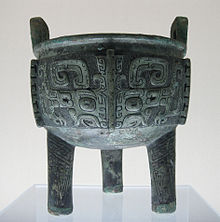A tripod is a portable three-legged frame or stand, used as a platform for supporting the weight and maintaining the stability of some other object. The three-legged (triangular stance) design provides good stability against gravitational loads as well as horizontal shear forces, and better leverage for resisting tipping over due to lateral forces can be achieved by spreading the legs away from the vertical centre. Variations with one, two, and four legs are termed monopod, bipod, and quadripod (similar to a table).
Etymology[edit]
First attested in English in the early 17th century, the word tripod comes via Latin tripodis (GEN of tripus),[1][2] which is the romanization of Greek τρίπους (tripous), "three-footed" (GEN τρίποδος, tripodos),[3] ultimately from τρι- (tri-), "three times"[4] (from τρία, tria, "three")[5] + πούς (pous), "foot".[6] The earliest attested form of the word is the Mycenaean Greek 𐀴𐀪𐀠, ti-ri-po, written in Linear B syllabic script.[7]
Cultural use[edit]

Many cultures, including the ancient peoples of China and Greece, used tripods as ornaments, trophies, sacrificial altars, cooking vessels or cauldrons, and decorative ceramic pottery. Tripod pottery have been part of the archaeological assemblage in China since the earliest Neolithic cultures of Cishan and Peiligang in the 7th and 8th millennium BC.[8] Sacrificial tripods were found in use in ancient China usually cast in bronze but sometimes appearing in ceramic form.[9] They are often referred to as "dings" and usually have three legs, but in some usages have four legs.
The Chinese use sacrificial tripods symbolically in modern times, such as in 2005, when a "National Unity Tripod" made of bronze was presented by the central Chinese government to the government of northwest China's Xinjiang Uygur Autonomous Region to mark its fiftieth birthday. It was described as a traditional Chinese sacrificial vessel symbolizing unity.[10]
In ancient Greece, tripods were frequently used to support lebes, or cauldrons, sometimes for cooking and other uses such as supporting vases.
Firearms[edit]

Tripods are commonly used on machine guns to provide a stable mount for the weapon when firing.[11]
Tripods are generally restricted to heavier weapons where the weight would be an encumbrance. For lighter weapons such as rifles, a bipod is more common. However, in recent times tripod saddles have become popular for precision rifle shooting sports, with the weapon placed in a vise-like rest which is mounted to a tripod head[12][13] or with the weapon mounted directly to the tripod head.
Photography[edit]

Surveying[edit]
Astronomy[edit]
The astronomical tripod is a sturdy three-leg stand used to support telescopes or binoculars, though they may also be used to support attached cameras or ancillary equipment. The astronomical tripod is normally fitted with an altazimuth or equatorial mount to assist in tracking celestial bodies.[14][15]
Laboratory[edit]

See also
1. A straight-grained wood of intermediate density, pinkish to red-brown in color; found principally in the West Indies, and Central and South America. Used primarily for interior cabinetwork and decorative paneling.
2. Wood from a number of tropical species which resemble mahogany, generally classified as to origin, i.e., African mahogany, Philippine mahogany, etc.
ma・hog・a・ny
━━ n., a. マホガニー(材)(で作った); 赤褐色(の); 〔話〕 食卓.To be under the mahogany, to be so drunk as to have fallen under the table. [Eng.]
To put one's legs under some one's mahogany, to dine with him. [Slang] ...
be under the mahogany 食卓の下に酔いつぶれて.
have one's knees under …'s mahogany 人と一緒に食事をする.
mahogany Show phonetics
noun [U]
a dark red-brown wood used to make furniture:
a handsome mahogany desk.
sup・per
━━ n. 夕食 ((特に,昼にdinnerをとった場合の)); 夜食; 夕食会.Last Supper (the ~) 最後の晩餐.
supper club 〔米〕 ナイトクラブ.
sup・per・less ━━ a. 夕食抜きの.
2085
Mahogany tripod or supper table. This version can also be used as a card table. The top tilts and is held in place by a brass catch, as with the o
| ||||
MAHOGANY
桃花心木是红色硬木,常见桃花心木有下列几种:
- 西印度群岛桃花心木(Swietenia mahagoni)产自古巴、巴哈马等加勒比海国家和美国佛罗里达州;
- 洪都拉斯桃花心木(Swietenia macrophylla)产自洪都拉斯和秘鲁、巴西等中南美国家。
- 非洲桃花心木(Swietenia Khaya)产自奈及利亞、黄金海岸等西非洲国家。
- 墨西哥桃花心木(Swietenia humilis) 产自墨西哥。
被称为“菲律宾桃花心木”的植物属龙脑香科(Dipterocarpaceae),并非桃花心木。
桃花心木是受保护的植物。
桃花心木主要用于制造高档家具、乐器和游艇、高档汽车的装璜等。

沒有留言:
張貼留言